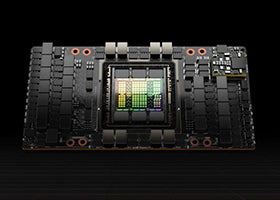
By Athanasios Koutsouridis, Marketing Manager
At One Stop Systems Inc. (OSS), we are proud to offer high-performance solutions that help our clients tackle the most demanding computing workloads. That's why we are excited to talk about the NVIDIA H100 Tensor Core GPU, an incredibly powerful GPU designed to deliver exceptional performance for a wide range of use cases.
The H100 is built on the cutting-edge NVIDIA Hopper GPU architecture, making it an ideal choice for applications that require lightning-fast compute power. With fourth-generation Tensor Cores, the H100 delivers up to 5x faster AI training and 30x faster AI inference speedups on large language models compared to the previous A100 generation, making it one of the most advanced GPUs on the market, and a perfect match for our PCIe expansions and GPU servers.
In this blog post, OSS will delve into the H100's architecture and hierarchy, and explore some of the exciting use cases that this GPU is ideal for. Whether you are working with complex AI models, or require high-performance computing for scientific research, the H100 GPU is a game-changing solution that will help you achieve your goals faster and more efficiently than ever before.
The H100 GPU Hierarchy and Architecture
The rapid advancements in GPU compute architecture have brought about a significant evolution in NVIDIA's latest H100 GPU hierarchy. While the CUDA programming model has relied on grids and thread blocks to achieve program locality for years, the conventional thread block approach has become inadequate with the growing complexity of programs and the emergence of GPUs with over 100 streaming multiprocessors (SMs).
To tackle this issue, NVIDIA has introduced an innovative Thread Block Cluster architecture with the H100 GPU. This architecture provides a greater degree of control over locality, allowing for larger granularity than a single thread block on a single SM. With Thread Block Clusters, the CUDA programming model has expanded to a new level, adding threads, thread blocks, thread block clusters, and grids to the GPU's physical programming hierarchy.

So, what exactly is a thread block cluster? Simply put, it is a collection of thread blocks that are scheduled concurrently onto a group of SMs. This new architecture aims to facilitate effective cooperation of threads across multiple SMs, leading to improved performance and execution efficiency.
The NVIDIA H100 GPU boasts numerous innovations, which makes it a powerhouse for OSS’ fields of AI Transportables and high-performance computing. Based on the new Hopper GPU architecture, the H100 is packed with cutting-edge features that make it more powerful, more efficient, and more programmable than any GPU that has come before it.
One of the most significant advancements in the H100 is its fourth-generation Tensor Cores, which perform matrix computations faster and more efficiently than ever before. This allows the H100 to handle a broader range of AI and HPC tasks with ease, making it an ideal choice for our clients who demand the best performance from their GPU.

The NVIDIA H100 is designed for high-performance computing workloads, and it is suitable for a wide range of use cases. Some of OSS’ most common client use cases for the H100 include:
Conclusion
At One Stop Systems Inc., we are constantly expanding our portfolio of high-performance GPU servers and PCIe expansions to provide our clients with the most advanced computing solutions available. We are proud to include the NVIDIA H100 in our line-up, as it represents a significant step forward in GPU technology.
The H100 is a high-end GPU that boasts numerous innovations, making it an ideal choice for our customers’ applications. With its advanced architecture and fourth-generation Tensor Cores, the H100 is one of the most powerful, programmable, and power-efficient GPUs to date, enabling users and applications to fully utilize all of their H100 GPUs' units at all times.
We believe that the H100 is an excellent choice for organizations that require high-performance computing capabilities. Its processing power and memory bandwidth make it ideal for handling the most demanding workloads, and its ability to deliver lightning-fast AI training and inference speedups on large language models make it a game-changing solution for organizations working with complex AI models.
Click the buttons below to share this blog post!

By: Jaan Mannik – Director of Commercial Sales
The term AI, or Artificial Intelligence, is everywhere nowadays and has quietly woven itself into the fabric of our daily lives. It powers the recommendations we see on streaming platforms, the navigation apps that guide us through traffic, and even the virtual assistants that answer our questions in seconds. From optimizing energy use in smart homes to predicting market shifts in finance, AI has become the invisible engine driving convenience, efficiency, and insight across industries.
In manufacturing, AI-driven robots collaborate with humans to streamline production. In agriculture, machine learning models monitor crops, forecast yields, and conserve resources. Retailers use predictive analytics to anticipate consumer needs before customers even express them. The reach of AI is no longer confined to futuristic labs, it’s in our phones, vehicles, and cities, constantly learning and adapting to serve us better.

OSS PCIe-based products deliver critical advantages for modern military sensor systems by enabling real-time data acquisition, processing, and transmission in rugged, mission-critical environments. These benefits stem from their ability to support high-bandwidth, low-latency interconnects, modular scalability, and environmental resilience, all of which are essential for today’s advanced military platforms.

Companies today are being asked to do more with data than ever before. Bigger AI models, faster insights, and workloads that don’t stay in one place, it’s a lot to keep up with. Traditional infrastructure just isn’t built for this kind of speed and flexibility.
The answer isn’t about throwing more hardware at the problem. It’s about building smarter, more agile infrastructure that adapts as demands change. And that’s where scale-out and increasingly, a blend of scale-out and scale-up come into play.